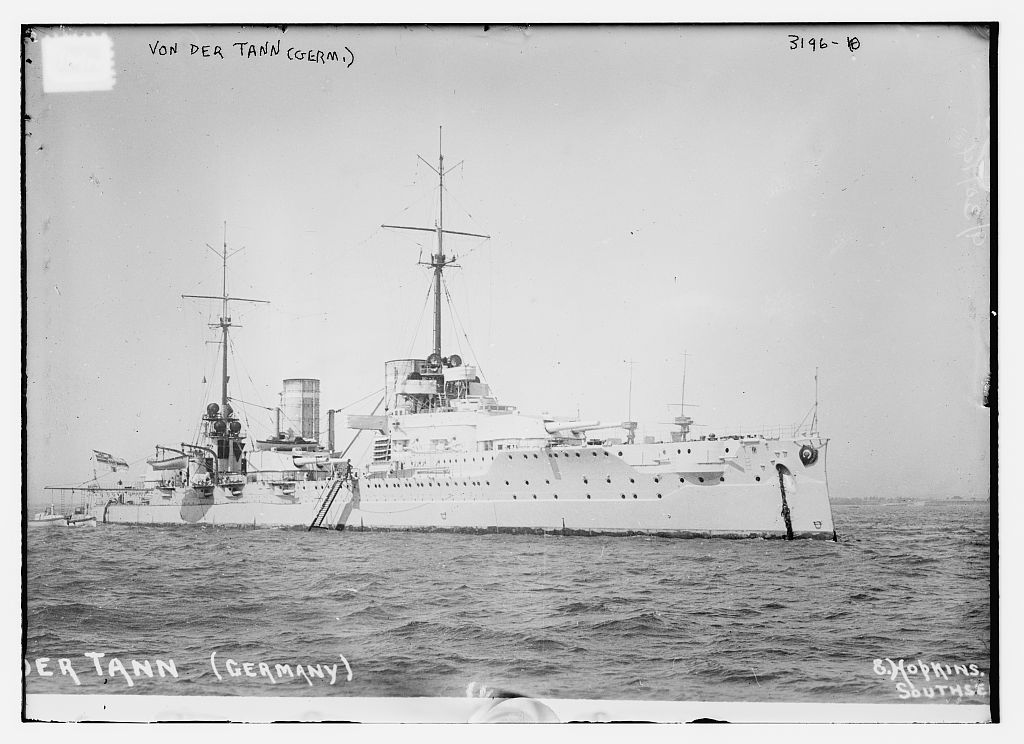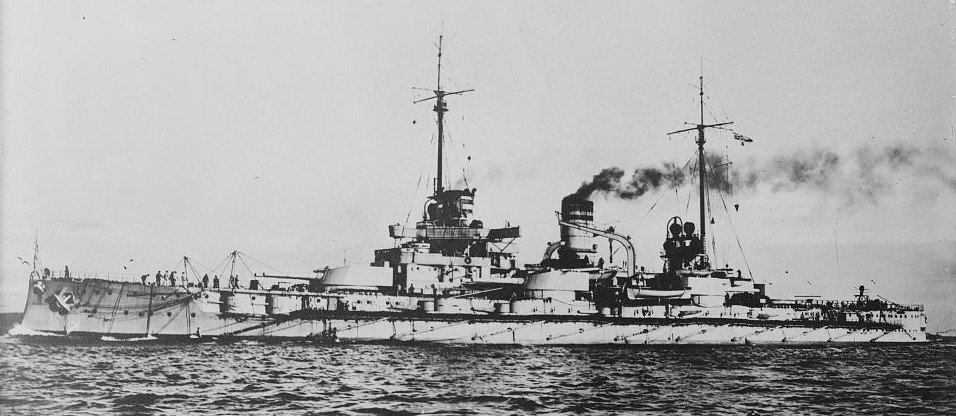

These guns were used to arm Germany's first "Dreadnought" type battleships and battlecruisers. The battlecruiser Von der Tann used these weapons to sink HMS Indefatigable at the Battle of Jutland (Skagerrak).
During World War II these guns were used only as coastal artillery. They were then supplied with a lighter shell with a larger propellant charge for increased range.
Constructed of A tube, two layers of hoops and a jacket. Used the Krupp horizontal sliding wedge breech block.
All German 28 cm guns had an actual bore diameter of 28.3 cm (11.1").
| Designation | 28 cm/45 (11") SK L/45 |
|---|---|
| Ship Class Used On | Nassau and Von der Tann Classes |
| Date Of Design | 1907 |
| Date In Service | 1909 |
| Gun Weight | 87,743 lbs. (39,800 kg) 1 |
| Gun Length oa | 501.4 in (12.735 m) |
| Bore Length | 472.7 in (12.006 m) |
| Rifling Length | 381.9 in (9.699 m) |
| Grooves | (80) 0.11 in D x 0.272 in W (2.8 mm D x 6.92 mm W) |
| Lands | 0.165 in (4.2 mm) |
| Twist | Increasing RH 1 in 45 to 1 in 30 at muzzle |
| Chamber Volume | 9,154 in3 (150 dm3) |
| Rate Of Fire | 3 rounds per minute |
- ^The often-seen figure of 117,947 lbs. (53,500 kg) for this weapon actually includes the weight of the Weige (gun cradle).
| Type | Cartridge - Bag |
|---|---|
| Projectile Types and Weights | These guns used the same projectiles in both World Wars as did the 28 cm SK L/50. Please see that datapage for information on them. |
| Propellant Charge | These guns used the same propellant charges in both World Wars as did the 28 cm SK L/50. Please see that datapage for information on them. |
| Cartridge Case Type, Size and Weight 1a | Brass, 283 x 1271 mm, about 99.2 lbs. (45.0 kg) 2a |
| Muzzle Velocity | World War I & World War II: 2,805 fps (855 mps)
World War II - HE L/4,4 nose and base fuze: 2,870 fps (875 mps) |
| Working Pressure | 20.9 tons/in2 (3,300 kg/cm2) |
| Approximate Barrel Life | 210 - 260 rounds |
| Ammunition stowage per gun | Nassau: 75 rounds
Von der Tann: 82.5 rounds |
- ^During World War I the same cartridge case was used for the 28 cm SK L/40, 28 cm SK L/45 and 28 cm SK L/50 guns. During World War II it appears that the same cartridge case was still used for these three guns and for the newer 28 cm SKC/28 and 28 cm SKC/34 guns.
- ^The cartridge rim diameter was 320 mm.
- For sketches of the projectiles and propellant fore and rear charges used with these guns, please see the 28 cm SK L/50 datapage.
| Elevation | Distance |
|---|---|
| 20 degrees
(maximum elevation of turrets) |
20,670 yards (18,900 m)
After 1915: 22,310 yards (20,400 m) 1b |
- ^A Note on Sources: The ranges for 20 degrees elevation are from "German Warships 1815-1945" but there is no explanation given for the 1915 increase in range other than stating that it was "after modifications to the gun mountings." Probably the maximum elevation was increased, but no other source says that this was done. "Naval Weapons of World War One" gives a range of 19,670 yards (18,000 m) at an elevation of 13.5 degrees, but this seems to be an error and was more likely the average gun range at 20 degrees.
| Range | Side Armor | Deck Armor |
|---|---|---|
| 13,120 yards (12,000 m) | 7.9 in (200 mm) | --- |
The above information is from "Die Geschichte der deutschen Schiffsartillerie."
| Range | Side Armor | Deck Armor |
|---|---|---|
| 10,930 yards (10,000 m) | 11.02 in (280 mm) | --- |
| 13,120 yards (12,000 m) | 7.9 in (200 mm) | --- |
The above information is from "German Battlecruisers of World War One" against nickel-steel plate.
| Designation | Two-gun Turrets
Nassau (6), Westfalen(6), Posen (4) and Rheinland (4): Drh LC/1906 1c 2c Posen (2), Rheinland (2), Von der Tann (4): Drh LC/1907 3c Single Coastal Artillery Turrets
|
|---|---|
| Weight | Drh LC/1906: 394 tons (400 mt)
Drh LC/1907: 418 - 428 tons (425 - 435 mt) |
| Elevation | Drh LC/1906: -6 / +20 degrees
Drh LC/1907: -8 / +20 degrees Coastal artillery: -5 / +50 degrees |
| Elevation Rate | Drh LC/1906: 3.5 degrees per second
Drh LC/1907: 4.0 degrees per second Coastal Artillery: 10 degrees per second with shell loaded |
| Train | End Turrets: About +150 / -150 degrees
Beam Turrets: About +80 / -80 degrees Coastal Artillery: -220 / +220 degrees |
| Train Rate | Drh LC/1906: 3.5 degrees per second
Drh LC/1907: 3.6 degrees per second Coastal Artillery: 4 degrees per second |
| Gun recoil | Nominal: 33.9 in (86 cm)
Mechanical Limit: 35.4 in (90 cm) |
| Loading Angle | Ships: 2 degrees
Coastal Artillery: 0 degrees |
- ^The Drh LC/1906 mountings used electrically powered training and elevation gear. The lower shell and propellant hoists were all fixed and there was no enclosing trunk. The working chamber and upper hoists revolved with the gunhouse and hoists. Hoists were cars which carried both projectiles and charges. Shells were in the middle of the car with the rear charge on top and the fore charge on the bottom. Electric chain rammers transferred all three to the loading locker from which they were passed to the manually operated loading trays and then hand rammed.
- ^Posen and Rheinland used LC/1906 for beam turrets and LC/1907 for end turrets.
- ^The Drh LC/1907 mountings used electrically powered training gear but the elevation gear was hydraulic. These mountings introduced lower hoists which rotated with the gunhouse.
- Battleships had the shell rooms located below the magazines. On Von der Tann, the bow and wing turrets had the magazines above the shell rooms but the stern turret had the magazine below the shell room.
- Following the Dogger Bank action, German mountings were modified to improve flash precautions. Double flap doors were installed at the beginning and end of the cartridge hoist and ready ammunition was removed from the gun houses.
- Gun axes were 89.4 in (227 cm) apart.
- Gunhouse crew for each gun was 12 men.
Armor thickness given in "Naval Weapons of World War One" by Norman Friedman Drh LC/1906 and Drh LC/1907
(except on Von der Tann)Drh LC/1907
(on Von der Tann)Face 11.0 in (28 cm) 9.1 in (23 cm) Sides 8.7 in (22 cm) 7.1 in (18 cm) Rear 10.2 in (26 cm) 9.1 in (23 cm) Roof 2.4 to 3.5 in (6 to 9 cm) 2.4 to 3.5 in (6 to 9 cm)
"Battleships of the World: 1905-1970" by Siegfried Breyer
"Jutland: An Analysis of the Fighting" and "Naval Weapons of World War Two" both by John Campbell
"Battleship Design and Development 1905-1945" and "Naval Weapons of World War One" both by Norman Friedman
"German Warships 1815-1945" by Erich Gröner
"The Big Gun: Battleship Main Armament 1860-1945" by Peter Hodges
"Die Geschichte der deutschen Schiffsartillerie" by Paul Schmalenbach
"German Battlecruisers 1914-18" and "German Battlecruisers of World War One: Their Design, Construction and Operations" both by Gary Staff
"German Capital Ships of World War Two" by M.J. Whitley
---
"Vorläufige Beschreibung der 28 cm S.K.L/45, 28 cm S.K.L/50 und 30,5 cm S.K.L/50 in Kst.Drh.L.C.37" M.DV.Nr. 234.6 Berlin 1941, Oberkommando der Kriegsmarine
"Munitionsvorschriften für die Kriegsmarine - Panzersprenggranaten (Psgr)" M.Dv. Nr. 190,1A2 by Oberkommando der Kriegsmarine
"Munitionsvorschriften für die Kriegsmarine - Sprenggranaten (Spgr)" M.Dv. Nr. 190,1A3 by Oberkommando der Kriegsmarine
"Munitionsvorschriften für die Kriegsmarine - Hülsenkartusche" M.Dv. Nr. 190,4A1 by Oberkommando der Kriegsmarine
"Munitionsvorschriften für die Kriegsmarine - Vorkartusche" M.Dv. Nr. 190,4A6 by Oberkommando der Kriegsmarine
---
U.S. Naval Technical Mission in Europe - Technical Report No. 393-45, September 1945, "Service Major Caliber Projectiles of the German Navy"
---
Special help from Peter Lienau and Thorsten Wahl
24 April 2008 - Benchmark
16 April 2009 - Replaced pictures of Von der Tann and Westfalen
20 May 2012 - Updated to latest template
24 November 2012 - Added details about guns, ammunition and mountings
18 July 2018 - Converted to HTML 5 standard, reorganized notes, added note regarding 1915 range
05 March 2019 - Reorganized notes and added data and sketches from M.Dv. Nr. 190,1A3, M.Dv. Nr. 190,4A1 and
M.Dv. Nr. 190,4A6
07 March 2020 - Added ammunition information
26 April 2020 - Minor changes for clarity
14 January 2022 - Added details to "zu etwa" note
31 December 2022 - Added Note on Sources for the (m.Hb) designation
19 November 2023 - Added propellant charge weights for pre-World War I and Source Note about gun elevation
28 August 2024 - Added burster notes and notes about projectiles and propellant charges being the same as
those used for the 28 cm SK L/50 guns
15 February 2025 - Minor formatting fix
